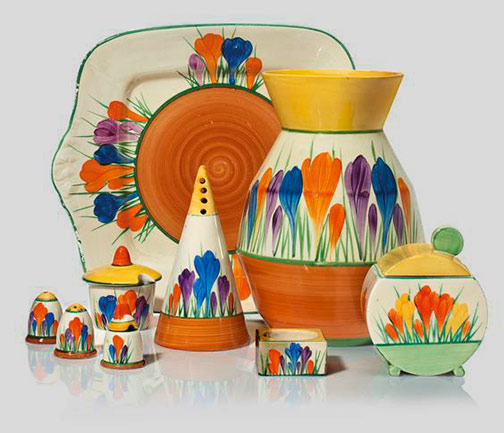Clarice Cliff is one of the most influential ceramics artists of the 20th Century and her work is collected, valued and admired the all over the World.
From the artful elegance of her transferware pieces to the bold colors and dynamic forms of her Art Deco Designs, British master Clarice Cliff trail-blazed her own path into ceramics celebrity. Today, Clarice Cliff pottery continues to capture the eye of cultured collectors, so in the spirit of her ongoing notoriety, this article will highlight her legendary career.
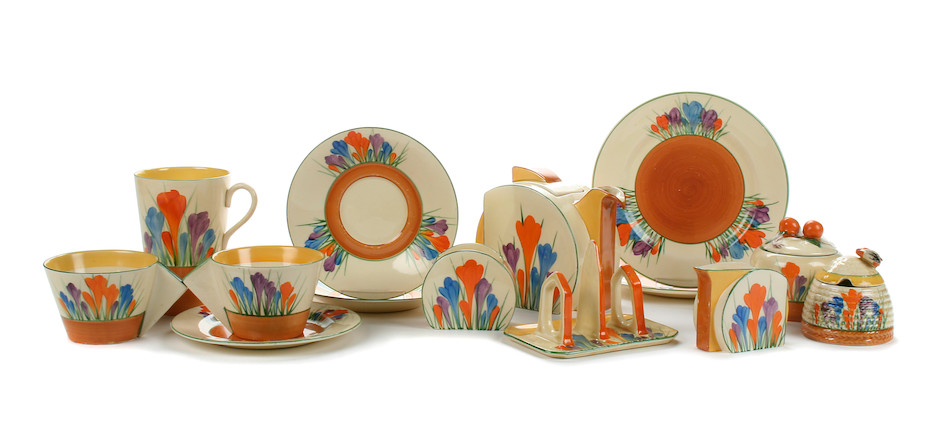
Born in 1899 in the heart of Stoke-on-Trent, one of England’s hubs for ceramic production, Clarice Cliff was born into a large working-class family and began work as an apprentice decorator at a local pottery factory in her early teens. She spent several years in Stoke-on-Trent learning skills and techniques, such as gilding and enameling, so she could lavish amazing designs and motifs on ceramic vessels, and she paired her work with nighttime study at the Burslem School of Art. Then, in 1916, Cliff took on a new position at the A.J. Wilkinson ceramic factory in Burslem, where her true talents as a ceramic artist were realized. In addition to sending her to London in the 1920s for a brief study stint at the Royal College of Art, Wilkinson’s owners also awarded Cliff her own studio at the nearby Newport Pottery factory.
Once installed at Newport Pottery, Cliff set out on a series of innovative designs in 1927 under what she called “Bizarre” wares. These vessels broke new ground in response to rising trends in Art Deco motif, and their immediate popularity meant that Cliff could hire apprentices to help decorate her designs. Her oversight of one of the era’s most thriving workshops – totaling by some accounts than seventy assistants – by the end of the 1920s led to her promotion to Art Director of all of Newport Pottery in 1930, a remarkable accomplishment for a female artist in the early twentieth century.
Cliff dominated the ceramics market of the 1930s with her brilliant combination of the bold geometry of the Art Deco movement and the defined, saturated colors associated with DeStijl masters like Theo van Doesburg or Piet Mondrian. This use of the modern art visual language in her wares granted them a vibrance and freshness that contemporary audiences adored.
The excitement for Cliff’s creations waned following World War II, and by the mid-1960s she officially retired. Her work was recognized in January 1972 in a solo exhibition, and though Cliff died later that same year, the interest in her work began to rise once again over the remainder of the decade. By the 1980s, reproductions of some of her most iconic series, like her ‘Age of Jazz’ figurines, were being released in large numbers. Meanwhile, museums began gobbling up her pieces; today, her wares can be seen in major collections like those of New York’s Metropolitan Museum of Art and London’s Victoria & Albert Museum.
Original “Bizarre” Clarice Cliff Pottery
Assessing Clarice Cliff pottery can be a challenge because, though she is best known for her “Bizarre” line, very often that term is applied as an umbrella category for different patterns she developed between the 1920s and 1930s. Looking for “Bizarre” pattern pieces on the auction market is sure to result in a wide variety of wares, so it can be helpful to dive a little deeper to learn what “Original Bizarre” means.
When Cliff first started exploring her “Bizarre” style, she experimented on old pieces of white ceramic held by Newport Pottery that were never sold because of imperfections in the vessel or its glaze. Cliff applied an array of bold color glazes in geometric planes to these damaged wares, not only hiding any errors of the vessel but transforming the piece altogether. The rapid rise of these designs to popularity meant Cliff could stop using the rejected vessels and instead make her own; it is these earliest versions, though, like this Lotus Jug, that are often called “Original Bizarre”, because they date to these early days. The “Bizarre” moniker, however, stuck around into the subsequent decade, appearing on popular lines such as “Bonjour”, “Melon” and “Blue Lugano” in the early years of the 1930s and with its backstamp appearing on wares until 1936.

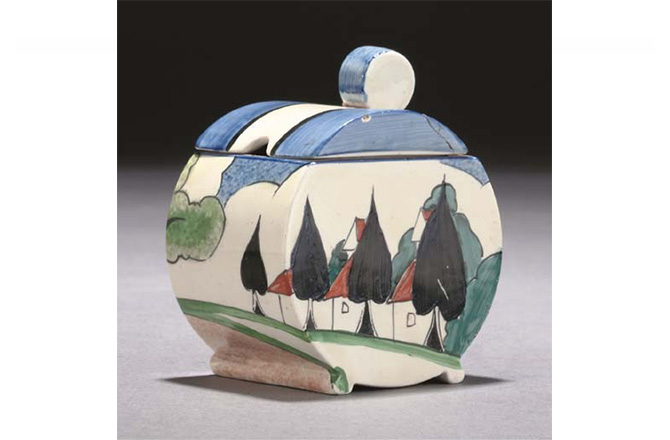

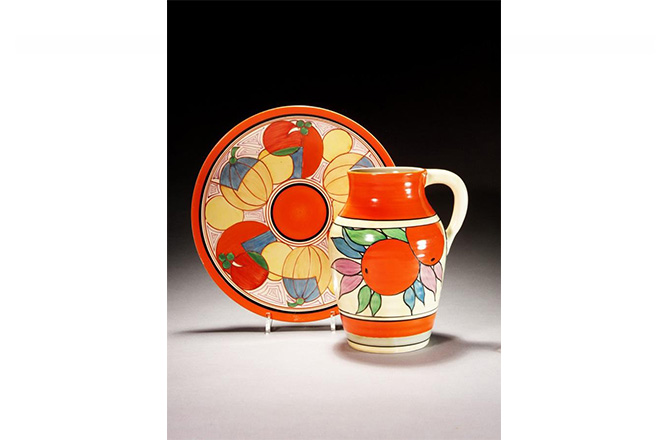
Clarice Cliff Specialty Shapes and Patterns
Given the rapid success of her initial “Bizarre” pottery and her novel design aesthetic, Cliff was invited in the mid-1930s to join a team of artists, including those associated with the British Bloomsbury Group, who would help to develop new designs for ceramic patterns that spoke to the modern era. These wares, such as Cliff’s ‘Circus’ pattern, were eventually featured in Harrod’s London in 1934 as part of a ‘Modern Art for the Table” campaign. At the same time, Cliff continued to explore some of her “Bizarre” themes in patterns like the colorful “Honolulu” and “Fantasque” motifs, both of which often depicted vignettes of the landscape illuminate in bright, enameled colors.



Clarice Cliff Figurines
One of the most innovative facets of Cliff’s production was her foray into figurines. She developed a number of series in her Art Deco aesthetic, some to be functional – like her “Lido Lady” ashtray – and others to serve as conversation-starting centerpieces. One such iconic series was the “Age of Jazz” figures, who originally emerged in the 1930s and were purportedly inspired by Cliff’s appreciation for the jazz tunes flooding radio waves at the time. One set of figurines from Clarice Cliff’s ‘Age of Jazz’ series broke records in 2018 when it sold at a Wooley & Wallis auction to an international collector for £15,000.
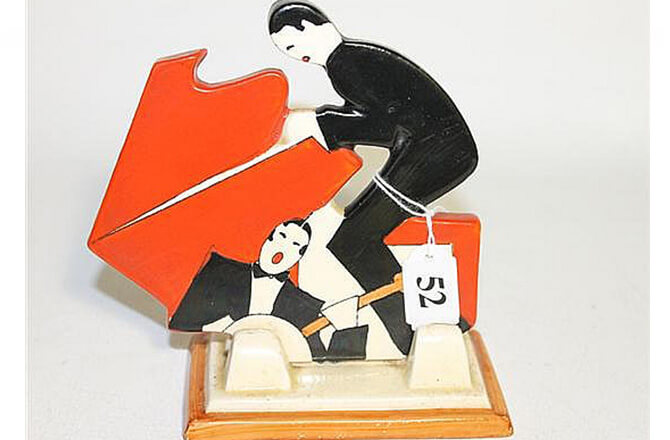

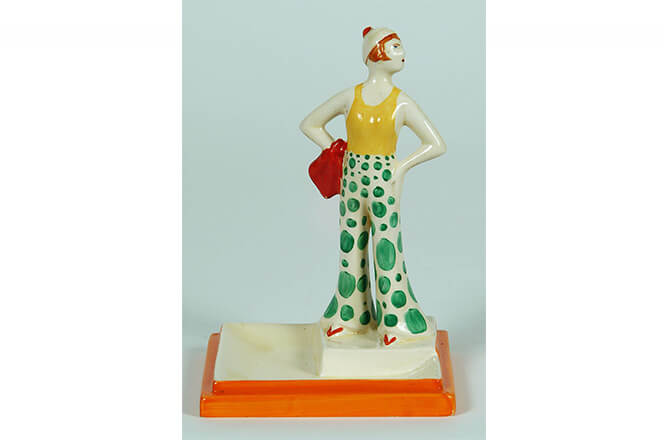
Worldwide appeal
Cliff’s worldwide impact was made clear by a story in the ‘Pasadena Evening Post’ in California, 1931, featuring her with a 5ft high horse made entirely of Bizarre. It was in this article, that Cliff made what has become her most famous quote: “Having a little fun at my work does not make me any less of an artist, and people who appreciate truly beautiful and original creations in pottery are not frightened by innocent tomfoolery.” The publicity she received in national press was unprecedented.
In the 1970s and 1980s their popularity was revived, leading to worldwide collectability, and establishing Cliff as one of the key names of the Art Deco movement. 1999 is celebrated worldwide as Clarice’s Centenary year. Cliff’s work continues to be esteemed and sought after by Art Deco ceramic collectors ever since.
The stunning colour and abstract design of Cliff’s ceramics often speaks for itself, and the geometric patterns can stir up a mixture of responses. Love it or hate it, you’ll always recognise a Cliff piece.
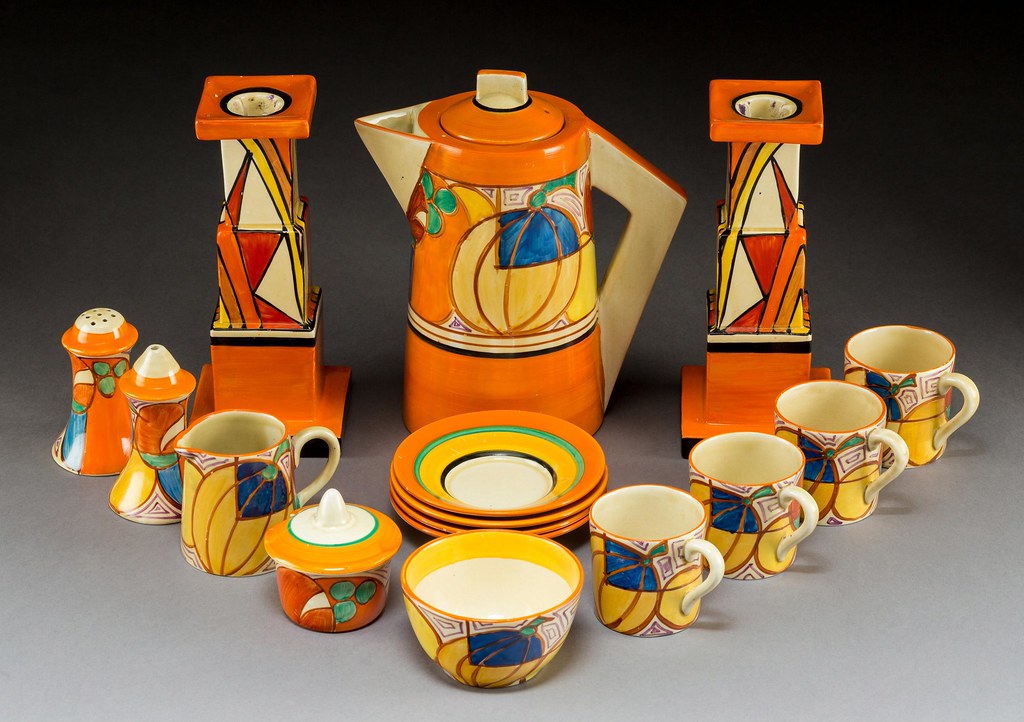
The Color Room – the movie
The film followed one of the most important British ceramicists journey from a young factory worker in Stoke to a legend of the Art Deco 1920s ceramic movement: Clarice Cliff, a determined, working class woman. In the 1920s, she broke the glass ceiling and revolutionized the workplace, while becoming one of the greatest Art Deco designers.
Phoebe Dynevor is well cast as Clarice as is Matthew Goode as the upper class factory owner and David Morrissey as her boss.
The Color Room is a movie that beautifully recreates Clarice Cliff’s spirit – to believing in yourself and never giving up on your dreams and if you have a passion for something you will find a way to overcome the obstacles that stand in your way!
Source: https://www.invaluable.com


